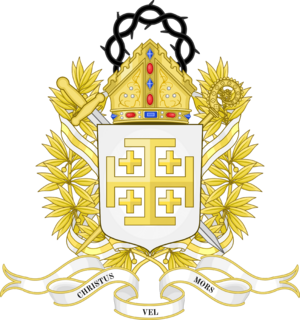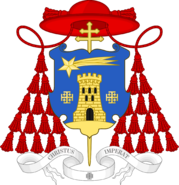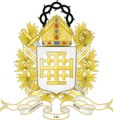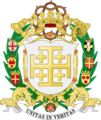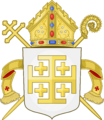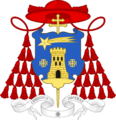Holy Land
The Holy Land (Latin: Terra Sancta) is a theocratic state in the Middle East, located near to the eastern coast of the Mediterranean Sea.
Government
Form of government
The term "theocracy" comes from the ancient Greek (θεοκρατία theokratía) and means "rule of God". In accordance with this definition, the government of the Holy Land legitimizes its regency by appealing to the Divine Will and the authority of the Holy See, which, within Catholic ecclesiology, acts as the highest magisterial instance on behalf of Jesus Christ, overseeing and guarding his flock. Consequently, the separation between state and religion is largely dissolved in the Holy Land: The government leads the state not only politically, but also religiously. The legislature, judiciary and executive branches of government are based on and guided by the principles of Catholic moral theology as well as by the Canon Law of the EMC Holy Catholic Church. Consequently, the Holy Land aims to impose the Christian religion as its state ideology in order to achieve the reign of Christ not only in the spiritual life but also in the geopolitical sphere.
Composition of government
The government of the Holy Land is divided into three administrative sections:
1. The See of Jerusalem (Latin: Hierosolymitanum Sedes), the head of the Archdiocese of Jerusalem: held by Cardinal Quarox, Archbishop of Jerusalem.
2. The Cathedral Chapter (Latin: Capitulum), the college of clerics who assist the Archbishop in his administrative duties of ecclesiastical (in that case also political) character, currently formed by:
I.) The Treasurer (Latin: Custos) of the Cathedral Chapter, Abbot Primate TheBetterHand (responsible for the structure, design and property of the churches as well as for the architecture in general).
II.) The Chancellor (Latin: Scholasticus) of the Cathedral Chapter, Cardinal Awuzup, later known as Cardinal Ratzinger (responsible for the libraries, the supervision of theological education and ensuring diplomacy in the area of external relations).
III.) The Dean (Latin: Decanus) of the Cathedral Chapter, Monsignor Hillsgolf (responsible for the bureaucratic internal and external management as well as for the announcing of declarations).
3. The Council of the Advocates of the Holy Land (Latin: Concilium Advocatorum Terrae Sanctae), the body of mayors of all towns within the Holy Land: currently consisting out of Indigo from Mons Regalis, iNinja from Byzant Theocracy, Crab from Crabistan, Cicraft from Holy Arabia, Orange from Magna, TheHeroBoy from Edessa, FrancyStrike from Arar and Alonjak from Ascalon. The title Advocate of the Holy Land was inspired by the traditional title of Godfrey of Bouillon, the first ruler of the Kingdom of Jerusalem, who accepted the title Advocate of the Holy Sepulchre in order to avoid the title of King, as it was considered inappropriate to be crowned as King in the land where Christ suffered with a crown of thorns.
History
Establishment
The Holy Land was first established in the form of the Catholic Theocracy of Israel (Latin: Theocratia Catholica Israelis). The Theocracy of Israel was founded as a town by Quarox, who was then a priest, on the 26th of March 2023. The reason for the foundation of this theocracy was a visit he made to Jerusalem: disappointed by the infidelity and unbelief that the young priest had to witness during his pilgrimage, he considered himself responsible to take action for the sake of his faith. In order to bring the government of Israel back to sanity, the cleric made an attempt to contact them by letter, explaining the issue and, despite the unfavorable imbalance of power between the insignificant priest and the fully grown nation in the Middle East, did not hesitate to state a warning about consequences if the government would not stop dishonoring the Holy Land. After the attempt to contact failed and the priest was mocked by propaganda posters additionally displayed in the streets of Jerusalem, Quarox appealed to the Holy See with a letter requesting authorization to establish the Catholic Theocracy of Israel in order to purify the Holy Land from the heresies he witnessed. Clement XV, Pope of that time, approved the establishment and at the same time elevated him to the episcopate on the 13th of March 2023. From that moment on, Quarox took over the ecclesiastical supervision over the Diocese of Israel as bishop. Due to the growth of this diocese, Pope Clement XV elevated it to the rank of Archdiocese of Jerusalem on the 6th of May 2023. The establishment of the Theocracy was solemnly promulgated in the Declaration of the Establishment of the Catholic Theocracy of Israel.
An excerpt from the document states: "In the context of their refusal to our request, to remove the propaganda of sodomy as well as the blasphemous visual amusements about Jesus Christ from their territory, we are compelled by our conscience to take fundamental and total countermeasures. Not only that they did not show any understanding for our accommodating request, much more these enemies of God intensified their sodomite propaganda and informed us about it, in a very mocking manner. Our littleness can bear much mockery for the sake of the one, who was humiliated, dishonored and crucified for our sake, but if we should see that at least a single heretic dares to harm even one hair of our beloved Lord, we are ready to raise against legions at the cost of our blood."
Towards the end it states: "Not acting on our own judgment, but strengthened in the name of the unshakable authority of His Holiness, Clement XV., Supreme Pontiff of the Universal Church, Holder of the Holy Roman See, whose loyal servants we are, and in view of the above explained diabolical behavior of the government of so-called Israel towards the most holy God and Savior, Jesus Christ, whose slaves we want to be forever, we officially declare and proclaim; I.) the outrageous claim of these infidels to identify themselves as Israel null and void, II.) the establishment of the Catholic Theocracy of Israel under the rule of Jesus Christ."
Independence
De facto, since its establishment, the Holy Land considered itself independent from other political entities, whereby as a theocratic Catholic state, it viewed itself solely responsible to the Holy See. Consequently, the process of independence that the Holy Land went through is to be understood in this context as a de jure phenomenon.
A few weeks after the establishment of the Theocracy, the government of the Holy Land decided to undertake a search for a neighboring nation to temporarily enter into a mutually beneficial unity. On the basis of successful diplomacy, the Theocracy chose in favor of joining the nation of Kushan. Although the initial cooperation proved to be fruitful and the Archdiocese of Jerusalem was able to christianize Kushan to the extent that it adopted Christianity as its official religion, the change of government in Kushan had a number of negative aspects. Through inappropriate behavior in the political context of the Middle East, Kushan made itself locally quite unpopular. This soon became an obstacle for the Archdiocese of Jerusalem regarding the evangelization of other neighboring nations. Third parties began to associate the Archdiocese of Jerusalem with Kushan and its actions, resulting in nations such as Egypt and Armenia rejecting evangelization attempts. In addition, it was revealed that Kushan's government had taken pleasure by publicly insulting His Holiness. These and other circumstances led the Holy See to make use of its authority in the following way: On the 3rd of July 2023, Pope Clement XV announced a decree regarding the independence of the Theocracy of Israel.
Among other matters, it stated: "It is with this proclamation, that I, Pope Clement XV, Supreme Pontiff of the Holy Catholic Church on EarthMC, decree the following: In the name of the people of God and His Church, I hereby order the town of the Theocracy of Israel to create a new sovereign, independent, and unbounded nation which shall act as the new Christian state in the Holy Lands following the dissolution of the Crusader States, in allegiance only to the will of God and in ever command of Christ [...] However, in observance of the peaceful and cordial diplomacy exhibited by the Christian nation of Kushan [...] The Church continues to extend its hand in friendship and partnership to Kushan."
And at the end: "I place my complete trust in the episcopal leadership of the Archdiocese of Jerusalem, under the See of Archbishop Quarox, to heed and carry out my command."
After several weeks of bureaucratic and economic preparations, the Theocracy of Israel finally promulgated the Declaration on the Independence of the Holy Land on the 5th of August 2023. The town of the Theocracy of Israel left Kushan, established the nation called Holy Land and from then on was the capital of this new nation.
The declaration stated: "Following the command of the former Pope Clement XV, the moment has arrived today when the Catholic Theocracy of Israel is facing a fundamental transformation [...] Considering the fact that our theocratic state is not subordinated to anyone except to Our Lord Jesus Christ and the Holy Catholic Church, as well as the fact of ceaseless political strife in the Middle East, the declaration of our independence from other nations gains extreme priority in order; I.) to finalize the autonomous sovereignty claim of our Lord and Savior over the Holy Land, II.) to eliminate the possibility of the Church being instrumentalized by any other nation and III.) to not allow the reputation of our Holy Mother Church to be in danger of being defiled by the misbehavior of other nations."
Towards the end: "Relying on the decree of the former Supreme Pontiff Clement XV and strengthened by the approval of the present holder of the Holy See, Pope Pius XIII, the Catholic Theocracy of Israel hereby declares; Its complete independence from any worldly authority and the establishment of the nation which shall be known as the Holy Land under the sovereign Reign of Our Lord Jesus Christ."
Coats of arms
The ecclesiastical hat is a distinctive part of the achievement of arms of a Catholic cleric. This hat, also called a galero, is a central element of the cardinal's coat of arms. The galero is ornamented with tassels on both sides, also called fiocchi. The color of the hat and number of tassels indicate the cleric's place in the ecclesiastical hierarchy. Generally, priests, abbots and ministers have a black hat with cords and tassels, the number depending upon their rank. Bishops generally use a green hat with green cords and six green tassels on each side, archbishops have likewise a green hat with green cords and ten green tassels on each side, and cardinals have a red hat with red cords and fifteen red tassels on each side. It also contains a cross: In the Catholic Church, display of a cross behind the shield is restricted to bishops and archbishops as a mark of their dignity and office. The cross of an ordinary bishop has a single horizontal bar or traverse, also known as the Latin cross. A archbishop or patriarch uses the Archiepiscopal cross with two traverses, also known as the Patriarchal cross. The Papal cross has three traverses. The shield is decorated with symbols that are directly or indirectly connected with the Holy Land. As with the other coats of arms, the Jerusalem cross is visible. The sand and the castle are intended to refer to the local natural and urban infrastructural conditions of the Middle East. On the blue background, which is meant to represent the sky, the Star of Bethlehem is depicted, which, according to biblical tradition, was visible at the birth of Christ. The praise Christus imperat, taken from the famous Laudes Regiae, serves as motto of the Cardinal's coat of arms and translates as Christ commands.
Expansion
[ . . . ]
External Political Alliances
Holy Roman Empire
[ . . . ]
Israel
[ . . . ]
Middle Eastern Strategic Alliance
[ . . . ]
External Political Conflicts
Israel
[ . . . ]
Caspian
[ . . . ]
Persian Empire
[ . . . ]
Antioche
[ . . . ]
Architecture
The architecture of the Holy Land is mostly inspired by the so-called historicism, in the context of art history, a common phenomenon in the late 19th and early 20th centuries during which architects and artists preferred to use architectural designs from previous centuries. The chief architect of the Holy Land is the Abbot TheBetterHand, who, inspired by the desire to express the beauty of God not only in the liturgy, but also in architecture, is responsible for the construction of the majority of Holy Lands architecture.
Saint James the Less Cathedral Basilica
Purpose
The Saint James the Less Cathedral Basilica (Latin: Ecclesia Cathedralis Basilicae Sancti Iacobi Fratris Domini) contains the See of the Archbishop of Jerusalem and therefore represents the spiritual and ecclesiastical center of the Archdiocese of Jerusalem. As the principal and mother church of the archdiocese, it is the place from which the local Archbishop exercises the duties of evangelization, liturgical service and pastoral supervision related with his office.
Construction
The construction of the cathedral was completed in April 2023. It is constructed according to the model of the real-life existing St. Peter's Church (located in Jaffa, Tel Aviv District, Israel) in the style of New Spanish Baroque. In August 2023, a Benedictine chapel was added to the left wing of the cathedral. This was supposed to symbolize, appreciate and honor the importance and impact of the Benedictine order for the Holy Land. In December 2023, a cemetery was completed on the left outside of the cathedral where memorials and graves are placed to honor and remember notable figures of the past, which had essential impact on the Holy Land: Among others, Canonicus Hononarius Diaconus NoSurfZone for his contribution to the construction of the city (May-December 2023), Monsignor Canonicus Hillsgolf for his great financial support (March-September 2023) and Pater Justice for his self-sacrificial military service (March-June 2023).
The cathedral has in total eight altars and has a traditional ad orientem direction. It contains a high altar, six side altars and one altar in the Benedictine chapel. The high altar is consecrated to St. James the Less (also known as James, brother of the Lord), thus the name of the cathedral. He was one of the Apostles and according to early Christian tradition first Bishop of Jerusalem. Four of the six side altars are dedicated to important saints from each of the four eastern patriarchates of the ancient church pentarchy: [1] John Chrysostom, Patriarch of Constantinople. [2] Ignatius, Patriarch of Antioch. [3] Athanasius, Patriarch of Alexandria. [4] Cyril, Patriarch of Jerusalem. The four patriarchal side altars are positioned in the cathedral according to the direction of the respective geographical location of the four patriarchal seats. The two other side altars are dedicated to two important figures of the Catholic faith: One is dedicated to the Holy Virgin Mary, Mother of God, while the other is dedicated to the first Roman Pope, St. Peter the Apostle. The altar in the chapel is dedicated to the father and founder of the Benedictine order, St. Benedict.
Consecration and Honors
The cathedral was personally consecrated by Pope Clement XV in April 2023 as part of the Pilgrimage to the Holy Land. In June 2023, Pope Clement XV granted the cathedral the honorary title of a basilica.
Coat of Arms
The cathedral has a characteristic coat of arms for a basilica with the so-called umbraculum. The coat of arms depicts two angels venerating the eucharistic host with the inscription JHS (Latin: Jesus Hierosolymae Salvator, 'Jesus, Saviour of Jerusalem') in a monstrance. The depicted saw serves as symbol for St. James the Less: It represents the method of his martyrdom. The Jerusalem cross is placed on the lower half.
Gallery
Crypt of the Noble Army of Martyrs
Purpose
The crypt, also known as the under-church, is a place used for liturgical purposes and for storing the tombs of saints, relic shrines, altars and other valuable objects of sacred origin. According to early Christian custom, the crypt originally contained the relics of a martyr. Based on this and with reference to the early Christian prayer Te Deum, the crypt of the Cathedral of St. James was named the Crypt of the Noble Army of Martyrs (Latin: Crypta Nobilis Martyrum Exercitus).
Construction
As is usual for crypts, it is located under the altar room and has a curved roof with a large number of pillars. The entrance to the crypt is located at the left outside of the cathedral in the cemetery. It contains an altar dedicated to the Noble Army of Martyrs, a statue of St. Mary, a statue of St. Joseph and statues in the sanctuary depicting the martyrs. Among these martyrs are saints who shed their blood for Christ on the ground of the Holy Land, including the Holy Innocents, St. Stephanus, St. John the Baptist, St. James the Less, St. James the Great, St. Simeon of Jerusalem and St. Alexander of Jerusalem. The exact year of construction has not been preserved to the present day.
Gallery
Cathedral Chapter
[ . . . ]
Archiepiscopal Residence
[ . . . ]
